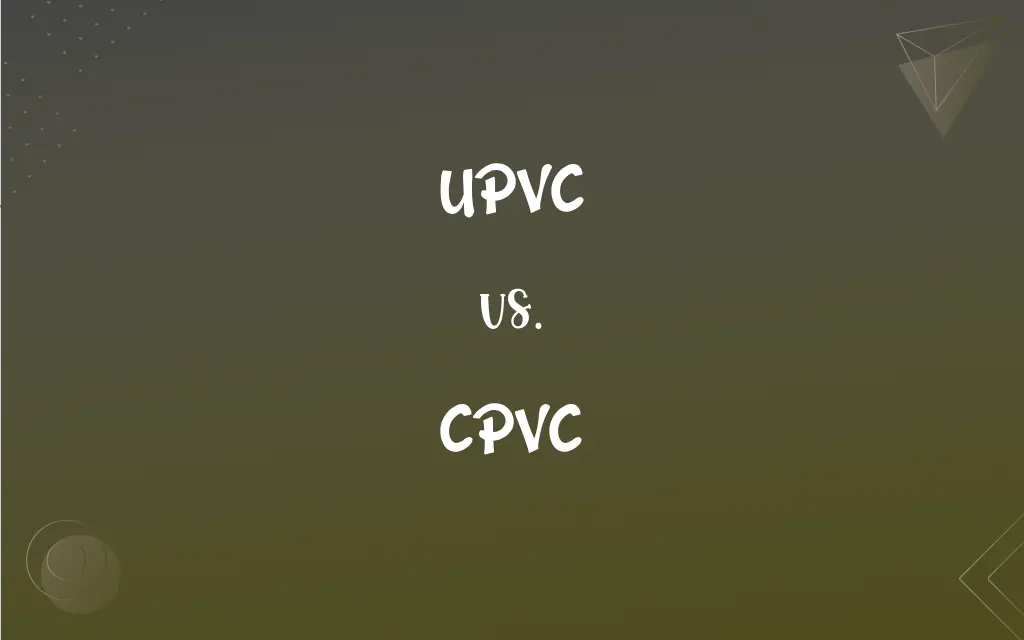UPVC vs. CPVC: What's the Difference?
Edited by Janet White || By Harlon Moss || Updated on October 25, 2023
UPVC (Unplasticized Polyvinyl Chloride) is a rigid, chemically resistant form of PVC used mainly for windows and doors, while CPVC (Chlorinated Polyvinyl Chloride) is a heat-resistant PVC variant used primarily for hot and cold water pipes.

Key Differences
UPVC, or Unplasticized Polyvinyl Chloride, is essentially PVC without added plasticizers, making it more rigid. CPVC, standing for Chlorinated Polyvinyl Chloride, is PVC that has undergone a chlorination process, enhancing its temperature resistance.
UPVC is widely used for constructing window frames and doors due to its rigidity and weather resistance. In contrast, CPVC, with its ability to handle higher temperatures, is predominantly used for hot and cold water piping systems.
UPVC boasts impressive durability, especially when used for exterior applications like windows, resisting various weather conditions. CPVC pipes, on the other hand, offer long-lasting performance in plumbing, resisting corrosion and scaling.
While UPVC is not designed to handle high temperatures, making it unsuitable for hot water systems, CPVC can withstand higher temperatures due to its chlorination, rendering it perfect for both cold and hot water plumbing.
Generally, UPVC products like windows and doors might be more expensive initially but offer long-term benefits in terms of maintenance and energy savings. CPVC pipes, being heat-resistant, might have a higher cost than regular PVC pipes but provide value in terms of durability and reduced maintenance.
ADVERTISEMENT
Comparison Chart
Composition
PVC without added plasticizers.
PVC that has undergone chlorination.
Primary Use
Window frames, doors.
Hot and cold water piping systems.
Temperature Resistance
Not designed for high temperatures.
Can handle higher temperatures.
Flexibility
Rigid.
Slightly more flexible than UPVC.
Cost
Might be pricier for initial installation.
Typically costlier than regular PVC due to enhanced properties.
ADVERTISEMENT
UPVC and CPVC Definitions
UPVC
A type of material used primarily for windows and doors.
The homeowner chose UPVC doors for better security and thermal efficiency.
CPVC
A variant of PVC modified for higher temperature resistance.
For the hot water line, the plumber recommended using CPVC pipes.
UPVC
A chemically resistant plastic suitable for external applications.
Due to its resistance to weathering, UPVC is a popular choice for outdoor installations.
CPVC
PVC that has undergone a chlorination process.
Through chlorination, CPVC gains properties that make it superior to regular PVC for certain applications.
UPVC
A rigid form of PVC without plasticizers.
UPVC windows are renowned for their durability and insulation properties.
CPVC
A heat-resistant plastic suitable for both hot and cold water systems.
Unlike other plastics, CPVC doesn't warp or deform easily when exposed to hot water.
UPVC
A non-flexible PVC variant.
Unlike flexible PVC, UPVC maintains its shape, making it ideal for structural uses.
CPVC
A chlorinated form of PVC used in plumbing.
CPVC is favored in plumbing due to its resistance to corrosion and scaling.
UPVC
A type of PVC known for its longevity and low maintenance.
Many prefer UPVC window frames because they don't need frequent repainting or sealing.
CPVC
A type of material known for its durability in plumbing systems.
Given its long lifespan, CPVC is considered a cost-effective choice for long-term plumbing projects.
FAQs
What are the main uses of uPVC?
uPVC is commonly used for window frames, door frames, piping, and guttering systems.
What are the benefits of using uPVC windows and doors?
uPVC windows and doors are durable, low maintenance, and provide good thermal insulation.
How does uPVC differ from PVC?
uPVC is the rigid form of PVC, meaning it doesn't contain any plasticizers that make PVC flexible.
What are the primary uses of CPVC?
CPVC is mainly used for hot and cold water distribution systems in residential and commercial properties.
What is CPVC?
CPVC stands for Chlorinated Polyvinyl Chloride, a plastic material used for piping systems, especially for hot and cold water distribution.
Is uPVC environmentally friendly?
While uPVC is long-lasting, it is not biodegradable. However, many manufacturers offer recycling programs for old uPVC products.
Can both uPVC and CPVC be recycled?
Yes, both materials can be recycled, but the recycling processes may vary.
How are uPVC and CPVC joined together in systems?
Typically, they are joined using solvent cement or push-fit mechanisms.
Can uPVC or CPVC be used for gas distribution?
Typically, neither material is recommended for gas distribution. Specialized materials are used for such applications.
Do uPVC and CPVC have similar density and weight?
While both are types of PVC, their densities can differ slightly due to the chlorination process in CPVC and the lack of plasticizers in uPVC.
What is uPVC?
uPVC stands for Unplasticized Polyvinyl Chloride, which is a type of rigid plastic often used in the construction industry, particularly for windows and doors.
Are uPVC and CPVC resistant to chemicals?
Both materials have resistance to many chemicals, but the resistance can vary depending on the specific chemical in question.
What colors are uPVC and CPVC typically available in?
uPVC is often white or cream, while CPVC is frequently available in a light yellow or cream shade.
How long do uPVC and CPVC products last?
Both materials are durable, with many products lasting for several decades if properly maintained.
Which is more expensive, uPVC or CPVC?
Costs can vary based on the application and region, but generally, CPVC may be more expensive than uPVC due to its enhanced properties.
Are uPVC and CPVC affected by UV light?
Prolonged exposure to UV light can degrade both materials, but additives can be incorporated to increase their UV resistance.
How does CPVC differ from PVC and uPVC?
CPVC is a chlorinated version of PVC, giving it the ability to withstand higher temperatures than both PVC and uPVC.
Why is CPVC preferred over PVC for hot water systems?
CPVC's resistance to high temperatures makes it more suitable for hot water systems compared to PVC, which can soften at elevated temperatures.
Is CPVC safe for drinking water?
Yes, CPVC pipes that are NSF-certified are safe for potable water distribution.
Can I paint over uPVC or CPVC?
While it's possible to paint both materials, proper surface preparation and the right type of paint are crucial for adhesion and longevity.
About Author
Written by
Harlon MossHarlon is a seasoned quality moderator and accomplished content writer for Difference Wiki. An alumnus of the prestigious University of California, he earned his degree in Computer Science. Leveraging his academic background, Harlon brings a meticulous and informed perspective to his work, ensuring content accuracy and excellence.
Edited by
Janet WhiteJanet White has been an esteemed writer and blogger for Difference Wiki. Holding a Master's degree in Science and Medical Journalism from the prestigious Boston University, she has consistently demonstrated her expertise and passion for her field. When she's not immersed in her work, Janet relishes her time exercising, delving into a good book, and cherishing moments with friends and family.































































